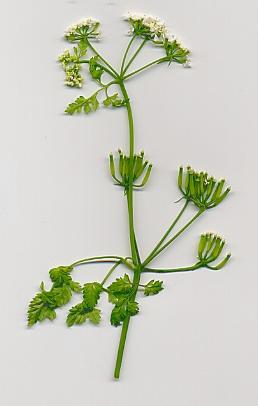|
|||||
|
|||||||
|
    An initiative of :Stichting Food-Info
|
| Food-Info.net> Food Products > Spices Chervil (Anthriscus cerefolium)Plant familyApiaceae (parsley family). Botanical synonyms- OriginProbably Southern Europe or the Caucasus region. Used plant partLeaves. They are nearly always used fresh, but can be preserved by deep-freezing or by making a pesto -like preparation. Sensoric qualitySweet and aromatic, somewhat intermediate between parsley and anis. On other spices with a similar fragrance. Main constituentsThe plant contains only minor amounts of essential oil (0.3% in the fresh herb, 0.9% in the seeds); it contains methylchavicol (estragole) and hendecane (undecane).
 Chervil flower cluster and unripe fruits UseChervil is popular in Central and Western Europe; the fresh leaves are chopped and added to soups, salads and fish dishes, much in the same way as parsley or coriander leaves. Herbal vinegar usually contains a few leaves of chervil. The dried herb is less aromatic than the fresh, but many compositions of the French herbes de Provençe contain dried chervil. In North European countries, chervil is often substituted by a related herb, cicely or Spanish chervil, which has a stronger, anis -like aroma. Source : www-ang.kfunigraz.ac.at/~katzer/engl/spice_welcome.html |
|
| ||
| Food-Info.net is an initiative of Stichting Food-Info, The Netherlands | ||||||